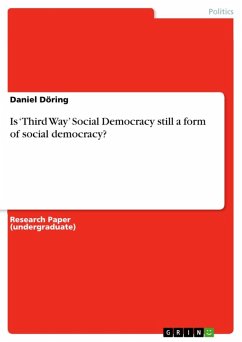Research Paper (undergraduate) from the year 2006 in the subject Politics - Political Systems - General and Comparisons, grade: 1,2, The University of Sydney, language: English, abstract: The concept of the "third way" stands broadly for an alternative middle way between two extreme positions. Known as "third way" is a middle form of socialism and capitalism, e.g. competition socialism, or new concepts of politics and economics, e.g. the free economy or the ordoliberalism. This shows that the "third way" can focus on economic, political and also cultural aspects, basically a mixture of it all. There are many different definitions for the "third way" of social democracy. This is on one side because the discussion about that is already happening for a long time and on the other because it is not lead uniformly. The term already appeared in context with the Euro communism or the "socialism of human countenance" (Alexander Dubcek) of the Prague Spring. But in that case it was always meant to be a middle way between communism and existing socialism. In the seventies of the 20th century the concept of "tredje vägen", the "third way" was shaped by Sweden's social democratic party and Olaf Palme (then prime minister of Sweden). However, the concept of today's "third way" is a middle course between unstrained turbo capitalism of neo-liberal stamping and the welfare state of Keynesian traditional stamping.
Dieser Download kann aus rechtlichen Gründen nur mit Rechnungsadresse in A, B, BG, CY, CZ, D, DK, EW, E, FIN, F, GR, HR, H, IRL, I, LT, L, LR, M, NL, PL, P, R, S, SLO, SK ausgeliefert werden.









